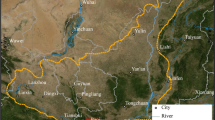Abstract
The property of silty-clay to clayey-silt quick clays, whereby apparently solid soil transforms to the liquid state when subjected to sufficient stress, derives from chemical factors: mineralogy (low activity); depositional environment (marine-to-brackish conditions causing flocculation and high water content); and post-depositional chemical changes (development of cementation and displacement of marine-to-brackish water by infiltrating rainwater). The stability of slopes developed by river incision is affected (negatively) by physical factors (drainage and fluctuating water tables) and chemical weathering reactions that have led to weak, fissured, blocky, nodular structures. Immediate causes of quick clay landslides are commonly the physical factors of: river erosion; high water contents in the fissured slopes; and human actions. Regardless, the characteristics of the resulting landslides are primarily determined by the chemical factors.
Access this chapter
Tax calculation will be finalised at checkout
Purchases are for personal use only
Similar content being viewed by others
References
Bjerrum L (1955) Stability of natural slopes in quick clay. Géotechnique 5:101–119
Broms BB, Boman P (1979) Lime columns – a new foundation method. In: American Society of Civil Engineers, Proceedings 105, GT4, pp 539–556
Bryhn OR, Löken T, Aas G (1983) Stabilization of sensitive clays with hydroxy-aluminium compared with unslaked lime. In: Proceedings of the eighth European conference on soil mechanics and foundation engineering, Helsinki, vol 2, pp 885–896
Demers D, Robitaille, Locat P, Potvin J (2014) Landslides in sensitive clays. Springer, Dordrecht
Eden WJ, Mitchell RJ (1970) The mechanics of landslides in Leda clay. Can Geotech J 7:285–296
Eide O, Bjerrum L (1955) The landslide at Bekkelaget. Géotechnique 5:88–100
Filion L, Quinty F, Bégin C (1991) A chronology of landslide activity in the valley of Riviѐre du Gouffre, Charlevoix, Quebec. Can J Earth Sci 28:150–256
Helle TE, Nordal N, Aagaard P, Lied OK (2016) Long-term-effect of potassium chloride treatment on improving the soil behavior of highly sensitive clay – Ulvensplitten, Norway. Can Geotech J 53:400–422
Helle TE, Aagaard P, Nordal S (2017) Improving the post-failure properties in quick clays by treatment with potassium chloride. In: Thakur V, L’Heureux J-S, Locat A (eds) Landslides in sensitive clays. From research to implementation. Springer, Dordrecht, pp 45–55
Karrrow PF (1972) Earth flows in the Grondines and Trois Riviѐres areas, Quebec. Can J Earth Sci 9:561–573
Kenney TC, Moum J, Berre T (1967) An experimental study of bonds in natural clay. In: Proceedings of the geotechnical conference, Oslo, vol 1
La Salle P, Chagnon J-Y (1968) An ancient landslide along the Saguenay River, Quebec. Can J Earth Sci 5:548–549
L’Heureux J-S, Locat A, Leroueil S, Demers D, Locat J (2014) Landslides in sensitive clay. ISSN 1878–9897, pp 15–24
Locat A, Leroueil S, Jostad HP (2014) Failure mechanisms of spreads in sensitive clays. Landslides in sensitive clay, ISSN 1878–9897, pp 279–290
Loiselle A, Massiera M, Sianani UR (1971) A study of the cementation bonds of the sensitive clays of the Outardes River region. Can Geotech J 8:479–498
Moum J, Sopp OI, Løken T (1968) Stabilization of undisturbed quick clay by salt wells. Norwegian Geotechnical Institute, Publication 81
Moum J, Löken T, Torrance JK (1971) A geochemical investigation of the sensitivity of a normally consolidated clay from Drammen, Norway. Géotechnique 21(4):329–340
Murad E (1988) Properties and behavior of iron oxides as determined by Mössbauer spectroscopy. Iron in soils and clay minerals. D. Reidel Publishing Company, Dordrecht
Tavenas F, Chagnon J-Y, LaRochelle P (1971) The Saint-Jean-Vianney landslide: observations and eyewitnesses accounts. Can Geotech J 8:463–478
Torrance JK (1983) Towards a general model of quick clay development. Sedimentology 30:547–555
Torrance JK (2012) Landslides in quick clay. In: Landslides: types, mechanisms and modeling. Cambridge University Press, Cambridge, pp 83–94
Torrance JK (2014) Chemistry, sensitivity and quick-clay landslide amelioration. Landslides in sensitive clay. ISSN 1878–9897
Torrance JK, Ohtsubo M (1995) Ariake Bay quick clays: a comparison with the general model. Soils Found 35:11–19
Torrance JK, Percival JB (2003) Experiences with selective extraction procedures for iron oxides. In: 2001. A clay odyssey, Proceedings of the 12th international clay conference, Bahia Blanca, Argentina, Elsevier, Amsterdam
Torrance JK, Hedges SW, Bowen LH (1986) Mössbauer spectroscopic study of the iron mineralogy of post-glacial marine clays. Clay Clay Miner 34(3):314–322
Acknowledgements
I wish to recognize: Murray Milford who introduced me to clay mineralogy; the late Cand. Real Johan Moum who introduced me to the chemistry of quick-clays, and the late L. H. Bowen who identified the iron oxides in the quick clays as being nanometer-sized, detrital, crystalline hematite and magnetite. I thank Dr. Mike Long for his insightful comments.
Author information
Authors and Affiliations
Corresponding author
Editor information
Editors and Affiliations
Rights and permissions
Copyright information
© 2017 Springer International Publishing AG
About this chapter
Cite this chapter
Torrance, J.K. (2017). Chemistry: An Essential Key to Understanding High-Sensitivity and Quick Clays and to Addressing Landslide Risk. In: Thakur, V., L'Heureux, JS., Locat, A. (eds) Landslides in Sensitive Clays. Advances in Natural and Technological Hazards Research, vol 46. Springer, Cham. https://doi.org/10.1007/978-3-319-56487-6_3
Download citation
DOI: https://doi.org/10.1007/978-3-319-56487-6_3
Published:
Publisher Name: Springer, Cham
Print ISBN: 978-3-319-56486-9
Online ISBN: 978-3-319-56487-6
eBook Packages: Earth and Environmental ScienceEarth and Environmental Science (R0)




